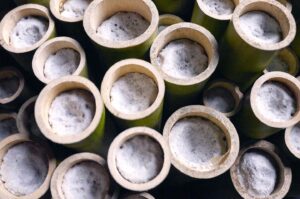Home fermentation is an ancient culinary craft that’s making a colossal comeback in kitchens worldwide. As people grow more health-conscious, they’re turning to home fermentation to create nutrient-rich, probiotic-packed foods that not only tantalize the taste buds but also offer remarkable health benefits. If you’re looking to embark on a fermentation adventure, you’re in the right place. This article will introduce you to the basics of getting started with home fermentation, ensuring you’re well-equipped to dive into this transformative culinary practice.
 Pin
Pin The images used in this article are credited to: Pixabay, Freepik, and other web-sources under non-commercial used.
Table of Contents
Understanding Home Fermentation
At its core, fermentation is a metabolic process that converts sugar to acids, gases, or alcohol. In the kitchen, it’s a method to preserve food, enhance flavor profiles, and increase nutritional value. Fermented foods like yogurt, sauerkraut, kimchi, and kombucha are gaining popularity, thanks to their connection with improved digestion, enhanced immune function, and a multitude of other health benefits.
Fermentation is a metabolic process that produces chemical changes in organic substrates through the action of enzymes. It has been a cornerstone of food preservation and flavor enhancement for thousands of years.
Equipment You'll Need
The beauty of fermentation lies in its simplicity and the minimal equipment required to get started. Here’s a detailed rundown of the essentials:
1. Glass Jars: Your primary fermentation vessels. Glass doesn’t react with the acids produced during fermentation, making it an ideal material. Wide-mouth Mason jars are especially popular for their accessibility and ease of use. The sizes may vary depending on the quantity of the produce you intend to ferment. A range of 16-ounce to 64-ounce jars should cover most needs.
 Pin
Pin 2. Airlocks: These devices allow gases produced during fermentation to escape while preventing outside air from entering the jar, thereby minimizing the risk of contamination by mold or bacteria. Airlocks are especially useful for long fermentations. They come in various styles but commonly fit on top of Mason jars.
 Pin
Pin 3. Weights: Weights keep your ingredients submerged below the brine (saltwater solution), which is crucial for an anaerobic (oxygen-free) fermentation process. You can find glass or ceramic weights designed to fit inside Mason jars. Alternatively, a small zip-top bag filled with brine can serve as an improvised weight.
 Pin
Pin 4. Wooden Tamper: A tamper helps in packing down the ingredients tightly in the jar. This is particularly useful for sauerkraut and kimchi to eliminate air pockets and ensure the produce is well-submerged in the brine. Any non-reactive, food-grade tamper will work.
 Pin
Pin 5. Non-Iodized Salt: Salt inhibits harmful bacteria, ensuring that only the beneficial bacteria thrive during fermentation. Use sea salt, kosher salt, or pickling salt without additives. Iodized salt can inhibit fermentation and should be avoided.
 Pin
Pin 6. pH Strips or a Digital pH Meter: These are optional but useful for monitoring the acidity level of your ferment. A pH of 4.6 or lower indicates a safe level for preventing the growth of harmful bacteria.
 Pin
Pin 7. Vegetable Chopper or Food Processor: While not strictly necessary, these tools can save time and effort, especially when you’re preparing vegetables for sauerkraut or kimchi.
 Pin
Pin 8. Measuring Cups and Spoons: Precision is key in fermentation, particularly for measuring salt to create the correct brine concentration.
 Pin
Pin 9. Clean Cloths or Coffee Filters: If you don’t use airlocks, covering the jar with a breathable cloth or coffee filter secured with a rubber band is an effective way to protect the ferment while allowing gases to escape.
 Pin
Pin 10. Large Mixing Bowl: A sizable bowl is essential for mixing ingredients before packing them into jars, especially for making sauerkraut or kimchi.
 Pin
Pin 11. Chopping Knife and Cutting Board: Basic tools for preparing vegetables and fruits for fermentation.
 Pin
Pin 12. Thermometer: Climate plays a significant role in fermentation. A kitchen thermometer helps you monitor the room temperature, ensuring it’s within the ideal range for fermentation (usually between 13°C and 24°C).
 Pin
Pin Remember, while the right equipment can facilitate the process, the key to successful fermentation lies in the balance of ingredients, salt, and time.
Choosing Your First Fermentation Project
1. Assess Your Interest and Goals: Start by considering why you’re drawn to fermentation. Are you looking to enhance your cooking with homemade condiments like sauerkraut or kimchi? Or are you more interested in the health benefits of fermented beverages like kefir or kombucha? Identifying your motivation will help narrow down your options.
2. Kitchen Space and Equipment: Before diving into a project, evaluate your available space and equipment. If you have limited space or are just testing the waters, consider starting with something that requires minimal equipment, like yogurt or simple vegetable ferments that can be done in a jar on your countertop. For those with more room and a desire to invest in specific equipment, you could venture into more complex ferments, such as beer brewing or cheese making.
3. Time Investment: Fermentation projects vary greatly in the time they take from start to finish. Quick ferments, such as lacto-fermented vegetables, might be ready in a few days to a week, making them ideal for beginners eager to enjoy results. Other projects, like certain cheeses or wines, may require months to mature. Choose a project that fits your patience level and schedule.
4. Complexity and Learning Curve: Some ferments, like sourdough bread, entail a steep learning curve and a great deal of hands-on attention, which might be daunting for beginners. In contrast, ferments like sauerkraut or pickles offer a simpler, more forgiving introduction to fermentation principles.
5. Flavor Preferences: Consider what you enjoy eating. There’s no point in making a gallon of kimchi if you’re not fond of spicy foods. Choose a project that leads to products you’re excited to try and that complements your diet.
6. Community and Resources: Starting with a popular fermentation project means you’ll have access to a wealth of knowledge from both the internet and possibly local communities. For your first project, it might be beneficial to choose something widely practiced, such as making kombucha or sauerkraut, to ensure you have ample support and resources.
The Fermentation Process: A Step-by-Step Guide
The art of fermentation is ancient, yet timeless, transforming simple ingredients into flavorful, probiotic-rich foods. Here’s a comprehensive step-by-step guide to help you master the fermentation process:
1. Preparation and Sanitation
- Sanitize Your Equipment: Begin with sterilizing all utensils, jars, and surfaces to prevent harmful bacteria from competing with the beneficial microbes. Boiling water or a vinegar rinse can be effective.
- Choose Fresh Ingredients: The best ferments start with high-quality, fresh ingredients. Organic produce is preferred to avoid pesticides that can hinder fermentation.
2. Chopping and Salting
- Chop Your Ingredients: Slice your vegetables or fruits into even pieces. The size can affect the fermentation speed and texture of the final product.
- Salt and Season: Mix your chopped ingredients with salt, and any desired spices. Salt inhibits harmful bacteria, allowing beneficial lactobacilli to dominate. The amount of salt can vary depending on the recipe but generally ranges from 2-5% of the weight of the produce.
3. Packing the Fermentation Vessel
- Pack Tightly: Place your mixture into your fermentation vessel, such as a glass jar or ceramic crock. Press down firmly to remove air pockets and ensure the produce is submerged beneath its liquid, which is crucial for an anaerobic fermentation environment.
- Weigh Down: Use a fermentation weight or a clean, smaller jar filled with water as a weight to keep the ingredients submerged under the brine. Exposure to air can lead to mold growth.
- Cover: Seal the vessel with an airlock lid to allow gases to escape without letting air in. Alternatively, a clean cloth secured with a rubber band can also work, though it may not be as effective in preventing mold.
4. Fermentation
- Store Properly: Keep the ferment in a dark, room-temperature spot (about 65-75°F or 18-24°C). Too hot, and the ferment could spoil; too cool, and fermentation will slow down.
- Monitor: Check your ferment daily, especially in the first few days. Skim off any mold that may form on the surface (it’s usually harmless but indicates too much exposure to air).
5. Testing and Storage
- Taste Test: After a few days, begin taste-testing the ferment. When it reaches a flavor profile you enjoy, it’s done. Fermentation times can vary widely, from a few days to several weeks, depending on the temperature and the produce used.
- Store: Once fermentation is complete, transfer the vessel to a cooler location like a fridge. This slows fermentation significantly, preserving the flavor and texture you’ve achieved.
6. Enjoying
- Incorporate into Meals: Your homemade ferment can be a flavor-packed addition to many dishes. Think beyond just a side dish – incorporate it into salads, sandwiches, and more.
Tips for Successful Home Fermentation
- Be Patient: Fermentation is a slow process. Allow your ferments the time they need to develop fully.
- Keep It Clean: Always use clean, sterilized equipment to avoid contamination.
- Monitor Your Ferments: Keep an eye on your fermenting foods for signs of mold or undesirable bacteria.
With this guide, you’re well on your way to unlocking the delicious and nutritional benefits of fermented foods right from your kitchen. Happy fermenting!
India
In India, fermentation is deeply woven into the culinary tapestry, with each region boasting its own special fermented delights. Home fermentation here is not just about preserving food; it’s also about enhancing nutrition and digestibility.
Dosa and Idli: South India is famous for its fermented rice and lentil dishes like dosa and idli. The batter is left to ferment overnight, which gives these dishes their characteristic tang and makes them more digestible.
 Pin
Pin Dhokla: This is a fermented snack from Gujarat made with a batter of rice and chickpeas.
 Pin
Pin Achar: Various types of pickles (achar) are made across India, using lactic acid fermentation to preserve seasonal fruits and vegetables, along with a blend of spices that add to the unique taste.
 Pin
Pin Japan
Japan’s fermentation traditions are equally rich and add a significant depth to its cuisine.
Miso: A fundamental ingredient in Japanese cooking, miso is made by fermenting soybeans with salt and koji (a type of fungus).
 Pin
Pin Sake: The fermentation of rice produces sake, a well-known Japanese rice wine.
 Pin
Pin Natto: Fermented soybeans known as natto are a staple in Japanese breakfast, valued for their strong flavor and sticky texture.
 Pin
Pin South Korea
Korean meals are incomplete without a serving of fermented dishes, which are revered for their health benefits.
Kimchi: Perhaps the most famous Korean ferment, kimchi is made by lacto-fermenting cabbage and other vegetables in a tangy, spicy brine.
 Pin
Pin Gochujang: This fermented chili paste is a crucial flavoring in Korean cooking, made from soybeans, salt, and red chili peppers.
 Pin
Pin Europe
Different regions in Europe have their unique fermenting traditions that have been passed down through generations.
Sauerkraut: In Germany, cabbage is fermented to produce sauerkraut, a dish that has been a staple in European diets for centuries.
 Pin
Pin Cheese and Yogurt: Europe is also known for its wide array of cheeses and yogurts, each with unique characteristics based on their fermentation processes.
 Pin
Pin Conclusion
Home fermentation journey is an exciting way to explore a world of flavors while boosting your health. With a bit of patience and creativity, you’ll soon be creating an array of delicious, probiotic-rich foods right in your own kitchen. Welcome to the fascinating world of home fermentation – where your culinary creativity knows no bounds!
Frequently Asked Questions (FAQs) About Home Fermentation
Fermentation is a metabolic process in which microorganisms such as bacteria, yeast, or fungi convert organic compounds – such as sugars and starch – into alcohol or acids. In food, this process not only preserves the food but also enhances its nutritional value and flavor, introducing beneficial probiotics.
Home fermentation allows you to create probiotic-rich foods that can improve gut health, enhance the nutritional profile of your diet, and reduce food waste. It’s also a fun and rewarding way to explore different flavors and culinary traditions.
Some beginner-friendly fermentation projects include sauerkraut, kimchi, yogurt, and kombucha. These require minimal equipment and ingredients but offer a great introduction to fermentation principles.
No, you don’t necessarily need special equipment. Basic kitchen tools, clean jars, and the right ingredients are sufficient to start. Some projects, like making kombucha, may require specific starter cultures.
Signs of successful fermentation include the production of bubbles, slight swelling of the fermentation container due to gas, and a noticeable change in taste and aroma of the ferment. These are indications that the beneficial microbes are active.
While fermentation is generally safe, it’s crucial to follow recipes and ensure cleanliness to avoid contamination. If you notice mold, a slimy texture, or an off odor, it’s better to discard the ferment and start over.
The fermentation time varies widely depending on the product and your taste preferences. It can range from a few days for vegetables like sauerkraut to several weeks or even months for items like certain cheeses or wines.
Key factors for successful fermentation include using fresh, quality ingredients; keeping equipment clean; following recipes closely at first; and ensuring your ferment is kept at an appropriate temperature and out of direct sunlight.
Most vegetables can be fermented, but some are more suitable than others. Crunchy vegetables like cabbage, carrots, and cucumbers tend to work best for beginners.
There are many books, online forums, community classes, and websites dedicated to fermentation. These resources can provide detailed recipes, troubleshooting tips, and support to help you master the art of home fermentation.

































